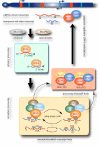piRNA and spermatogenesis in mice
- PMID: 23166399
- PMCID: PMC3539364
- DOI: 10.1098/rstb.2011.0338
piRNA and spermatogenesis in mice
Abstract
Transposable elements and their fossil sequences occupy about half of the genome in mammals. While most of these selfish mobile elements have been inactivated by truncations and mutations during evolution, some copies remain competent to transpose and/or amplify, posing an ongoing genetic threat. To control such mutagenic sequences, host genomes have developed multiple layers of defence mechanisms, including epigenetic regulation and RNA silencing. Germ cells, in particular, employ the piwi-small RNA pathway, which plays a central and adaptive role in safeguarding the germline genome from retrotransposons. Recent studies have revealed that a class of developmentally regulated genes, which have long been implicated in germ cell specification and differentiation, such as vasa and tudor family genes, play key roles in the piwi pathway to suppress retrotransposons, indicating that the piwi-mediated genome protection is at the core of germline development. Furthermore, while the piwi system primarily operates post-transcriptionally at the RNA level, it also affects the epigenetics of cognate genome loci, offering an intriguing link between small RNAs and transcriptional control in mammals. In this review, we summarize our current understanding of the piwi pathway in mice, which is emerging as a fundamental component of spermatogenesis that ensures male fertility and genome integrity.
Figures

Similar articles
-
Mouse MOV10L1 associates with Piwi proteins and is an essential component of the Piwi-interacting RNA (piRNA) pathway.Proc Natl Acad Sci U S A. 2010 Jun 29;107(26):11841-6. doi: 10.1073/pnas.1003953107. Epub 2010 Jun 1. Proc Natl Acad Sci U S A. 2010. PMID: 20534472 Free PMC article.
-
MOV10L1 is necessary for protection of spermatocytes against retrotransposons by Piwi-interacting RNAs.Proc Natl Acad Sci U S A. 2010 Jun 29;107(26):11847-52. doi: 10.1073/pnas.1007158107. Epub 2010 Jun 14. Proc Natl Acad Sci U S A. 2010. PMID: 20547853 Free PMC article.
-
The regulatory functions of piRNA/PIWI in spermatogenesis.Yi Chuan. 2017 Aug 20;39(8):683-691. doi: 10.16288/j.yczz.17-245. Yi Chuan. 2017. PMID: 28903896 Review.
-
Blockade of pachytene piRNA biogenesis reveals a novel requirement for maintaining post-meiotic germline genome integrity.PLoS Genet. 2012;8(11):e1003038. doi: 10.1371/journal.pgen.1003038. Epub 2012 Nov 15. PLoS Genet. 2012. PMID: 23166510 Free PMC article.
-
piRNAs and their involvement in male germline development in mice.Dev Growth Differ. 2012 Jan;54(1):78-92. doi: 10.1111/j.1440-169X.2011.01320.x. Epub 2012 Jan 6. Dev Growth Differ. 2012. PMID: 22221002 Review.
Cited by
-
Effect of ovarian stimulation on the expression of piRNA pathway proteins.PLoS One. 2020 May 4;15(5):e0232629. doi: 10.1371/journal.pone.0232629. eCollection 2020. PLoS One. 2020. PMID: 32365144 Free PMC article.
-
Male Infertility in Humans: An Update on Non-obstructive Azoospermia (NOA) and Obstructive Azoospermia (OA).Adv Exp Med Biol. 2021;1288:161-173. doi: 10.1007/978-3-030-77779-1_8. Adv Exp Med Biol. 2021. PMID: 34453736 Review.
-
When Dad's Stress Gets under Kid's Skin-Impacts of Stress on Germline Cargo and Embryonic Development.Biomolecules. 2023 Dec 6;13(12):1750. doi: 10.3390/biom13121750. Biomolecules. 2023. PMID: 38136621 Free PMC article. Review.
-
Circular RNAs: biogenesis, expression and their potential roles in reproduction.J Ovarian Res. 2018 Jan 17;11(1):9. doi: 10.1186/s13048-018-0381-4. J Ovarian Res. 2018. PMID: 29343298 Free PMC article. Review.
-
Mouse GTSF1 is an essential factor for secondary piRNA biogenesis.EMBO Rep. 2018 Apr;19(4):e42054. doi: 10.15252/embr.201642054. Epub 2018 Feb 7. EMBO Rep. 2018. PMID: 29437694 Free PMC article.
References
-
- Gundry M, Vijg J. 2012. Direct mutation analysis by high-throughput sequencing: from germline to low-abundant, somatic variants. Mutat. Res. 729, 1–1510.1016/j.mrfmmm.2011.10.001 (doi:10.1016/j.mrfmmm.2011.10.001) - DOI - DOI - PMC - PubMed
-
- Friedberg EC, Walker GC, Siede W, Wood RD, Schultz RA, Ellenberger T. 2005. DNA repair and mutagenesis, 2nd edn. Washington, DC: ASM Press
-
- Kazazian HH, Jr, 2004. Mobile elements: drivers of genome evolution. Science 303, 1626–163210.1126/science.1089670 (doi:10.1126/science.1089670) - DOI - DOI - PubMed
-
- Matsui T, Leung D, Miyashita H, Maksakova IA, Miyachi H, Kimura H, Tachibana M, Lorincz MC, Shinkai Y. 2010. Proviral silencing in embryonic stem cells requires the histone methyltransferase ESET. Nature 464, 927–93110.1038/nature08858 (doi:10.1038/nature08858) - DOI - DOI - PubMed
-
- Rowe HM, et al. 2010. KAP1 controls endogenous retroviruses in embryonic stem cells. Nature 463, 237–24010.1038/nature08674 (doi:10.1038/nature08674) - DOI - DOI - PubMed
Publication types
MeSH terms
Substances
LinkOut - more resources
Full Text Sources
Other Literature Sources

